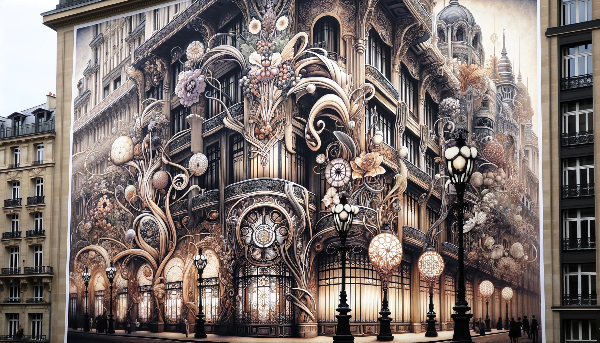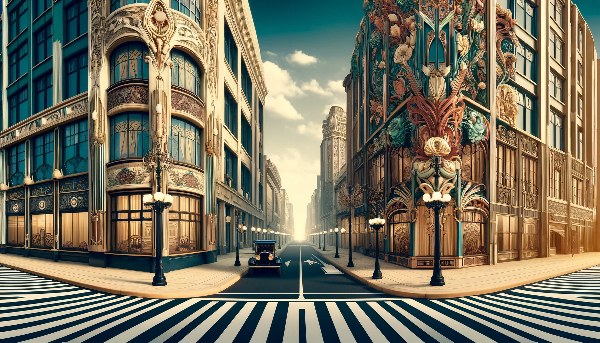Art Nouveau and Art Deco are two emblematic artistic movements that have left an indelible mark on architecture, furniture, and decorative arts in France and around the world. Each of these styles emerged in a distinct era, reflecting the aspirations and sensibilities of their respective periods. This article proposes to explore the nuances between Art Nouveau and Art Deco, highlighting their influences on various artistic and cultural aspects.
Origins and Historical Context
Art Nouveau: a revolutionary movement
Art Nouveau, which appeared at the end of the nineteenth century, is often associated with a reaction against previous academic and historical styles. This movement sought to create a new aesthetic, emphasizing organic and natural forms. Artists like Gustav Klimt and Hector Guimard were leading figures in this movement, bringing innovations in architecture and design.
Art Deco: The Style of Modern Elegance
In contrast, Art Deco emerged in the 1920s, after the First World War. This style is characterized by its geometric shapes, luxurious materials, and stylized patterns. It symbolizes a period of prosperity and optimism. Personalities such as René Lalique and Henri Sauvage helped popularize this movement through their works in the fields of furniture and architecture.
Key features
Art Nouveau: nature as a source of inspiration
Art Nouveau is known for its sinuous lines and nature-inspired patterns, such as plants and flowers. Art Nouveau architecture, represented by buildings like Hector Guimard's Castel Béranger in Paris, uses organic forms and innovative materials to create fluid and harmonious structures.
Art Deco: The Alliance of Geometry and Luxury
Art Deco, on the other hand, is distinguished by its geometric patterns and expensive materials like marble, ivory, and ebony. Art Deco furniture, such as dressers and bars, is often adorned with zigzag patterns, clean lines, and metallic finishes. Art Deco architecture is exemplified by buildings such as the Chrysler Building in New York City, which combines elegance and modernity.
Influence on Architecture
Architecture Art Nouveau
Art Nouveau architecture is characterized by a bold use of curves and floral ornaments. In France, architects like Hector Guimard played a crucial role in the spread of this style. Notable examples include the Parisian metro entrances, famous for their organic shapes and decorative details.
Art Deco Architecture
In contrast, Art Deco architecture emphasizes rigid geometric shapes and luxurious materials. This style was popularized by buildings such as the Palais de Chaillot in Paris and the Théâtre des Champs-Élysées. Art Deco also spread internationally, influencing constructions in Tokyo, New York and beyond.
The Impact on Furniture and Interior Design
Art Nouveau Furniture
The Art Nouveau furniture are distinguished by their graceful curves and natural patterns. The designs of Victor Horta and Antoni Gaudi are iconic examples of this style, often incorporating sculptural elements and innovative materials.
Art Deco Furniture
Art Deco furniture, on the other hand, is known for its clean lines and luxurious materials. Art Deco bar furniture and Art Deco dressers combine functionality with sophisticated aesthetics, often using exotic veneers and lacquer details.
Artists and Their Contributions
Art Nouveau artists
Artists such as Gustav Klimt, with his paintings rich in floral motifs, and Alphonse Mucha, famous for his elegant posters, contributed greatly to the fame of Art Nouveau. Their works are characterized by meticulous attention to detail and innovative use of organic forms.
Art Deco artists
Art Deco also saw the emergence of many influential artists. René Lalique, known for her glass creations, and Tamara de Lempicka, with her stylized portraits, marked the movement with their bold use of geometric shapes and precious materials. The Art Deco lamp was one of the essential decorative elements of this period.
The Impact of the First World War
The First World War marked a break between Art Nouveau and Art Deco. While Art Nouveau reached its peak before the war, Art Deco flourished in the post-war period, reflecting the social and economic changes of the time. This transition illustrates how historical events can influence artistic and cultural trends.
International Influence
Art Nouveau in Europe
In Europe, Art Nouveau found varied expressions across the continent. In Belgium, Victor Horta was a pioneer of this style, while in Spain, Antoni Gaudi incorporated Art Nouveau elements into his unique architecture in Barcelona.
Art Deco on a Global Scale
Art Deco, on the other hand, spread far beyond Europe. In Tokyo, buildings such as the Tokyo National Museum of Western Art show the influence of this style. In New York City, iconic skyscrapers like Rockefeller Center embody the Art Deco aesthetic, combining luxury and modernity.
Materials and Techniques Used
Materials in Art Nouveau
Art Nouveau is characterized by the use of materials such as glass, wrought iron, and ceramics. Artists and architects have often collaborated with craftsmen to create works of great finesse and remarkable technical complexity.
Materials in Art Deco
Art Deco, on the other hand, is distinguished by its use of precious and luxurious materials. Exotic wood veneers, shiny metals, and gemstones are commonly used to create objects and furniture that embody elegance and sophistication.
World Expos and their Role
1900 Universal Exhibition in Paris
The 1900 Universal Exhibition in Paris was a key moment for Art Nouveau, providing a platform for artists and architects to showcase their creations to the world. Ornate pavilions and innovative works illustrated the richness and diversity of this movement.
International Exhibition of Decorative Arts of 1925
In 1925, the International Exhibition of Modern Decorative and Industrial Arts in Paris was decisive for the recognition of Art Deco. This event brought together works from various countries, highlighting the innovation and luxury inherent in this style, especially the future Art Deco furniture from the 30s.
Distinctive Shapes and Patterns
Shapes and Motifs of Art Nouveau
Art Nouveau is distinguished by its floral motifs and organic shapes, often inspired by nature. Sinuous curves and flowing lines are omnipresent, creating a harmonious and delicate aesthetic.
Art Deco Shapes and Patterns
Art Deco, on the other hand, is characterized by geometric patterns and clean shapes. Zigzags, chevrons, and fan patterns are commonly used, reflecting a taste for symmetry and rigor.
Influencing Industrial Design
Industrial Design and Art Nouveau
Art Nouveau influenced industrial design by introducing organic shapes and natural patterns into everyday objects. William Morris' designs in England are an example of this approach, combining functionality and aesthetics.
Industrial Design and Art Deco
Art Deco, on the other hand, marked industrial design with the integration of luxurious materials and geometric shapes. Objects produced during this period, such as radios and appliances, reflect a modern and sophisticated aesthetic.
The Differences Between Art Nouveau and Art Deco
Differences in Aesthetics
Art Nouveau and Art Deco are mainly distinguished by their respective aesthetics. Art Nouveau favors natural shapes and organic patterns, while Art Deco emphasizes geometric shapes and luxurious materials.
Differences in Cultural Influence
Art Nouveau emerged as a reaction to traditional academic styles, seeking to renew the decorative arts through a more natural and fluid approach. Art Deco, on the other hand, reflects a period of modernity and prosperity, incorporating influences from industry and technology.
FAQ
What is the main difference between Art Nouveau and Art Deco? Art Nouveau is characterized by organic shapes and natural patterns, while Art Deco favors geometric shapes and luxurious materials.
Who are the emblematic artists of Art Nouveau? Gustav Klimt, Hector Guimard, and Antoni Gaudi are major figures of Art Nouveau.
How did Art Deco influence industrial design? Art Deco introduced luxurious materials and geometric shapes into everyday objects, creating a modern and sophisticated aesthetic.
Where can you see examples of Art Nouveau architecture in Paris? The Parisian metro entrances designed by Hector Guimard are emblematic examples of Art Nouveau architecture.
What are the typical Art Deco materials? Art Deco uses materials such as marble, ivory, ebony, and shiny metals.
How did the First World War influence these artistic movements? World War I marked the end of Art Nouveau and the beginning of Art Deco, reflecting the social and economic changes of the time.
Conclusion
Art Nouveau and Art Deco are two distinct artistic movements that have profoundly influenced architecture, furniture and decorative arts in France and internationally. Each of these styles reflects the values and aspirations of their respective times, helping to enrich the world's cultural heritage. By exploring the differences and similarities between these two movements, we can better understand their lasting impact on our artistic and cultural environment.




